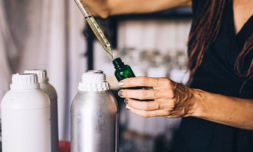Prompted by an industry-wide pivot to more sustainable production practices, several companies have started trialling fragrances made from carbon dioxide pollution.
Though I’m sure you’d rather not be reminded, the world, as we know, is well and truly running out of time to offer up solutions that’ll prevent climate change from doing its worst.
Fortunately, no doubt motivated by the continued influx of warnings from every activist, organisation, and governing body genuinely invested in getting us out of this mess, industries at fault of waiting far too long to change their ways have been clamouring to cooperate – albeit some of them by resorting to greenwashing – in recent years.
At the helm (and rightly so given it produces 120 billion units of packaging to be thrown out annually) is beauty, a sector that’s largely reliant on natural resources and finally well-aware of how urgently action is required to save the planet if it has any hope of staying afloat.
Of the many innovations that have reared their heads as of late to reflect this understanding, from technological integration to circular business models that minimise waste, one stands out in particular for seeking to address an issue that grows more pressing by the day.
With cutting emissions no longer a viable option in terms of rectifying the insurmountable quantity of carbon we’ve poured into the atmosphere – to the point where the Amazon is now emitting more CO2 than it’s able to absorb – companies are getting creative.
Namely Air Company, a start-up on a relentless mission to stop the villainous by-product of human life on Earth and the greenhouse gas most responsible for our ecological crisis from wreaking any more havoc on the environment than it already has.
View this post on Instagram
How? By turning air into perfume.
This is achieved with a process that’s currently making waves across the globe for its potential to reduce society’s CO2 emissions by over 10%, according to an analysis by the University of Michigan’s Global CO2 Initiative.
‘I don’t see a path to net zero without these kinds of technologies,’ says Richard Youngman, CEO of Cleantech Group.
‘The commitments corporations have been making can’t be met by renewable energy alone.’


















